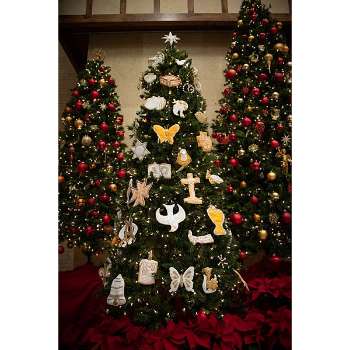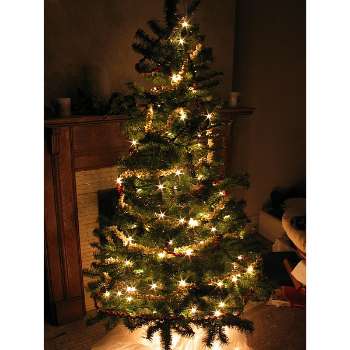How Old are Christmas Trees When Cut? On my farm, I grow Christmas trees, which I normally cut down when they are between 6 and 10 years old. To make sure they are ready for tree lots, harvesting starts in early to mid-November.
It’s interesting to note that the history of Christmas trees is extremely extensive, with the 16th century being attributed with the beginning of the custom as we know it today in Germany. In those days, devoted Christians carried adorned trees inside their houses.
But cultivating Christmas trees isn’t as straightforward as planting a tree and harvesting it after a few years. It’s an all-year commitment that takes a lot of effort. While many people may only consider Christmas trees in December, for us farmers who cultivate cut-your-own trees, it is a year-round operation that takes attention and care.
In terms of harvesting, it usually takes place between early and mid-November. This schedule makes sure that when customers start shopping for Christmas trees, they will be accessible and prepared for tree lots. To pick the ideal tree for their holiday festivities, customers often visit “choose-and-cut” Christmas tree farms like the one in Maryland.
It’s important to note that different tree species have various rates of growth. Popular cultivars like the Noble Fir, for example, need six to ten years to achieve the proper height. Large retailers started installing massive lit Christmas trees in the early 1900s, enhancing the holiday ambiance.
Proper handling and storage are essential for ensuring that Christmas trees remain fresh and maintain their freshness. On-farm cold storage for weeks before to export allows trees to maintain their original freshness.
In conclusion, growing Christmas trees requires a lot of effort and is a year-round activity. It’s a lengthy procedure that starts with planting the trees, continues with caring for their development over many years, and ends with harvesting and distributing the trees in time for the Christmas season.
These trees are carefully cultivated and grown to a suitable height before they are harvested and brought to market for sale during the holiday season. The age of a christmas tree is an important factor in ensuring that it has reached the ideal size and shape for display in homes and businesses.
The cultivation process involves regular pruning and shaping to encourage fullness and symmetry, resulting in the picturesque trees that are synonymous with the festive season. As a result, when you bring a christmas tree into your home, you are enjoying the product of several years of careful nurturing and cultivation.
| Christmas Tree Height | Age Range (Years) |
|---|---|
| 5 ft | 4-7 years |
| 6 ft | 6-10 years |
| 7 ft | 7-15 years |
| 8 ft | 10-12 years |
Understanding The Growth Cycle Of Christmas Trees
Understanding the growth cycle of christmas trees is essential to knowing how old they are when cut. A christmas tree goes through different stages in its life, starting as a seedling and eventually growing into a mature tree. Factors such as the species of the tree, climate conditions, soil quality, and care practices contribute to its growth rate.
Each year, a christmas tree adds a new layer of growth called a growth ring, which can provide an estimate of its age. By examining the number of growth rings, we can determine the approximate age of a cut christmas tree.
This knowledge can help us better appreciate the effort and time it takes for these beautiful trees to reach our homes during the holiday season.

Determining The Ideal Age For Cutting Christmas Trees
Determining the ideal age for cutting christmas trees depends on the tree species. For popular trees like balsam fir, fraser fir, and douglas fir, they are typically around 6-10 years old when harvested. These species are known for their excellent needle retention and vibrant color.
On the other hand, scotch pine and white pine can be cut after 5-7 years. Although they may not hold their needles as well as the fir trees, they are still a popular choice. Age plays a crucial role in tree quality and needle retention.
Younger trees tend to have softer needles and retain moisture better, resulting in a fresher appearance. However, it’s important to cut the tree at the right time to ensure optimal health and longevity for your christmas centerpiece.
Also Read : 10 Interesting & Fun Facts About Christmas Trees
Harvesting Techniques For Optimal Timing
Christmas trees are typically cut between 8 to 12 years old, ensuring the optimal size and shape. Harvesting techniques play a crucial role in determining the right time to cut the tree. There are several signs to look for when a tree is ready to be cut.
Firstly, the color of the needles should be a vibrant green. Secondly, the branches should be sturdy and evenly spaced. Thirdly, the tree trunk should be straight and strong, able to bear the weight of ornaments. To properly handle the tree after it is cut, it is recommended to transport it in a netting sleeve to prevent any damage.
It is also important to keep the tree in a water stand to maintain its freshness throughout the holiday season. By following these best practices, you can ensure that your christmas tree remains beautiful and vibrant throughout the holidays.

The Environmental Impact Of Cutting Christmas Trees At Different Ages
Christmas trees can vary in age when they are cut, which has both positive and negative effects on the environment. The age of a christmas tree when it’s cut affects its ability to absorb carbon dioxide and release oxygen, impacting the overall carbon footprint.
Younger trees absorb more carbon dioxide, making them environmentally beneficial. However, cutting trees at a younger age limits their potential to grow bigger and provide more shade and habitat for wildlife. On the other hand, older trees have a higher carbon storage capacity but are less efficient in absorbing carbon dioxide.
Sustainable practices in christmas tree farming aim to strike a balance between these factors, ensuring that trees are cut at the right age to minimize environmental impacts. This includes planting new trees to replace the ones cut and promoting responsible farming practices to maintain healthy ecosystems.
Also Read : Why Did My Christmas Cactus Leaves Turn Purple – How to Fix(6 Reasons)
Frequently Asked Questions Of How Old Are Christmas Trees When Cut
How Long Does It Take For A Christmas Tree To Grow?
Christmas trees typically take anywhere from 6 to 10 years to reach maturity and be ready for harvest. The growth rate can vary depending on the tree species and environmental conditions. It requires patience and careful cultivation to ensure healthy and full-grown christmas trees.
What Age Are Most Christmas Trees When They Are Cut?
Most christmas trees are typically cut when they are between 7 and 10 years old. This age ensures that the trees have reached their optimal size and shape for use as christmas decorations. Cutting them at this age also allows for sustainable harvesting and encourages new growth for the future.
Are Younger Or Older Christmas Trees Better?
Both younger and older christmas trees have their advantages. Younger trees tend to have softer needles, making them easier to decorate and handle. On the other hand, older trees often have denser branches, providing a more substantial display of ornaments.
Ultimately, it comes down to personal preference and the specific look you desire for your holiday decor.
How Long Do Christmas Trees Live After They Are Cut?
Once cut, christmas trees can typically stay fresh and retain their needles for about 4 to 6 weeks if properly cared for. Regular watering, keeping the tree away from heat sources, and using tree preservatives can help prolong its lifespan.
After that period, the tree will start to dry out and may become a fire hazard.
Conclusion
Understanding the age of christmas trees when they are cut is fascinating and sheds light on the process behind our beloved holiday traditions. Whether you opt for a young tree or a more mature one, both can bring joy and festive cheer into your home.
By considering factors such as growth rate, species, and individual preferences, you can make an informed decision when choosing a christmas tree. Remember to consider sustainability practices such as tree farms and recycling options to ensure your holiday celebrations align with eco-conscious choices.
Embrace the magic of christmas with a beautifully decorated tree, knowing that its age and journey to your living room contribute to the enchantment of the season. Happy holidays!
